Paschke Online
Designs Ink Publishing Article Archive and Reference Library
Articles by Chris A. Paschke, CPF GCF
"What To Do With: Diplomas, Degrees and Certificates"
July 2002
Since the time for graduation has come and gone and diplomas of every size and shape abound, it is the perfect time to enter into a discussion of mounting and framing certificates. There has been on-going debate for years over the practices surrounding the mounting and framing of these items. There are both ethical and physical issues that must be addressed with documents, which can impact the way in which these treasures are framed. Ethically is whether or not they are to be handled as originals, and physically is the mounting method that will not damage them.
Ethical Issue: Mounting an Original
We must always remember diplomas are original one-of-a-kind documents. Though they may technically be replaced if damaged or lost, but depending upon date of issue there may be a difference in the current appearance of the new copy, or the authority who originally signed the document may be retired or deceased. In any event the original is now a new original and not a duplicate at all.
Documents, certificates and diplomas should always be framed as an original, one that may never truly be duplicated. That means only conservation hinging and noninvasive mounting methods must be used during framing. Cooked starch paste hinges, Mylar or folded mulberry corners, or edge strips would be logical solutions. Yet there remain customers who will insist on flattening the document by gluing them down.
Educating the customer is necessary to instruct as to the impact that humidity, heat and moisture have on paper and animal skins. They need to be taught that the rippled appearance of a real sheepskin parchment is the 'nature of the beast' and part of its beauty.
Physical Issue: Can Parchment be Mounted?
Ethically, real parchment should not be permanently mounted. Regardless of wet, spray or dry mounting, the question isn't can sheepskin be mounted, but should it be mounted. Physically, wet mounting might work if the skin was not stretched during the initial hide preparation. Spray and pressure-sensitive mounting is difficult with vellum and parchment because of the oils inherent in the skins. As far as dry mounting, many animal skins will tolerate moisture or heat when applied separately, it's the combination of heat and moisture that can kill the animal (photo 1).
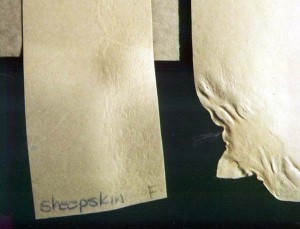 Photo 1: Sheepskin Samples
Photo 1: Sheepskin Samples
The left sample shows a scrap of sheepskin that has been dampened and air dried. There is a slight natural shrinkage due to the stretched cleaning and dehairing process. The right sample shows the unfortunate damage resulting from the combination of heat and moisture when applied to parchment.
Always test the skin for heat and moisture sensitivities as well as ink permanence prior to even considering dry mounting. Try to convince your customer that the natural cockling of the skin is it's true nature and that dignity should be maintained. If all of this is too scary then conservation mount the document, as it should be.
University Recommendations
When diplomas are issued to a graduate they are often accompanied by a notice from the registrar concerning the care and framing of the valued degree. A framing job I completed for a recent New York University graduate included such a note. It stated the diploma was a "...valuable document which deserves special care against loss or damage...on the finest parchment paper obtainable...warranted to resist shrinkage, corrugation, and age discoloration. It...should be removed from the mailer and kept flat, preferable in a frame...not regularly exposed to direct sunlight." So far this is just sound framing practice, but it goes on to say, "Diplomas will not be replaced...under no circumstances will issue a duplicate of an original. In the event of loss or damage...the University will supply...a Certificate of Graduation to serve as a legal substitute for the original document".
Makes a framer think twice about attempting to mount any diploma, doesn't it? The note also states this is parchment paper and not true sheepskin parchment.
Sheepskin (Parchment), Vellum or Paper
Depending upon the university or school from which the degree originates it could be real sheepskin, or a high quality neutral pH paper with school colors, emblem and often gold accents. Genuine sheepskin parchment is used for printing, writing and bookbinding whenever excellence or distinction is desired. This is the reason many ivy league universities continue to produce diplomas on original sheepskin instead of artificial parchment or fine grade printing paper. The skins from sheep are whiter, which is why they are often preferred to vellum, but are also oilier than other skins.
Vellum is the proper name given for any high quality animal skin, excluding sheep or lamb. Though all writing skins are often referred to as 'parchment', the only true parchment comes from sheep. Calf, goat and sheep were normally and most frequently used, but skins of gazelle, antelope, stag and ostrich have also been preserved.
As mentioned above there are parchment papers that have been developed to replicate the look of a real sheepskin. There are very inexpensive versions found in art stores for less than a dollar a sheet. There are also those of higher quality neutral pH materials for a few dollars more. Tracing vellum has no relation to animal skin with the exception of the translucency of the paper which emulates the oily appearance of a skin. The terms parchment and vellum refer to both original skins and artificial versions, making the terminology confusing at best.
Damaged Original
Earlier I was discussing the ethical issues of mounting a diploma or valued document. Aside from the personal and ethical feelings there can be legal implications in mounting something for someone. When a customer insists on mounting a diploma flat because of its natural tendency to cockle as a professional you must make that ethical decision between mounting it against your better judgement or turning the job away. There will always be a framer who will mount it for the customer if you do not.
About ten years ago there was the case in California where a highly knowledgeable, well respected, upper end, professional framer did as the customer requested and mounted a series of diplomas for his office. There was a signed disclaimer for the mounting and customer was thrilled with the finished pieces when he picked them up. Some time later he returned attacking the framer with a law suit for irreparable damage over the mounting of these irreplaceable originals to a solid surface. He felt the diplomas were worthless since they had been mounted even though he was the item of graduate value and not the papers. The lawsuit was for $1,000 each for punitive damages over them.
Whether the framer won or lost is not the important issue here but that it can happen at all. We must always remember it is our job as a professional to enhance and protect. Not make judgements that will irreversibly impact any original. Stand your ground. It is never worth your reputation or the loss of your business profits to give in to the demands of a customer to what you know is mishandling.
Digital Certificates and Heat Tolerance
Another source of mounting damage is the heated dry mounting system in relation to digital certificates. In past years certificate blanks were often mass produced without names and dates until awarded. As needed, calligraphers were hired to fill in the necessary elements. With the onset of in-house digital printing came the filling in of the names and dates by office printers. As long as these are inkjet printers the resulting certificates are safe to dry mount.
But if laser printers are used they are often susceptible to heat damage, and many a name has been transferred from the original document to the release paper meant to protect it from adhesive contamination. Should these certificates have not been mounted? Because of their physical intolerance to heat they should not have been, but ethically maybe it was OK. It depends on the document.
Valued Certificates
Phase change is a type of inkjet which uses a solid wax-based CMYK color ink stick or puck. The wax ink is heated then projected onto the substrate surface through the nozzle onto the paper. This type of printing is generally considered more commercial and will print on many types of substrate.
Piezoelectric
Replaceable does not mean, not valuable, nor without emotional attachment, but rather those that might be replaced if necessary. Perfect attendance awards, academic achievement honors and participation in sports certificates are all emotionally valuable but can be ethically mounted without fear of repercussions (photo 2).
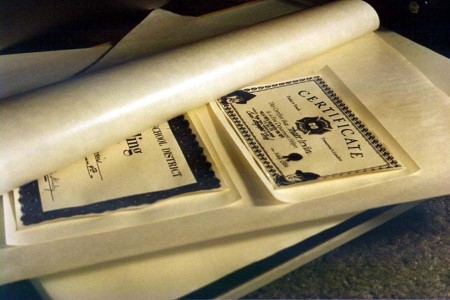 Photo 2: Flat Mounting
Photo 2: Flat Mounting
These certificates of achievement are sitting on top of sized tissue adhesive in double sided release paper ready to be premounted. They will then be trimmed and centered onto a colored mat backing for flat mounting, as seen below.
There are levels of value with certificates just as there are open edition images and limited editions. Some certificates are emotionally valued such as graduation from kindergarten. They tolerate heat and should be safely presented, but just as there are photos that are mounted and those that are not, there will remain certificates that may end up mounted and diplomas that will not. Many of these mountable, though still originals, are likely to be able to be easily replaced. And in many cases the mounting may add to their longevity, as with Ansel Adams and his photos (photo 3).
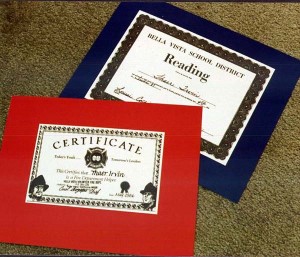 Photo 3: Replaceable Certificates
Photo 3: Replaceable Certificates
Replaceable does not mean not valuable, or not with emotional attachment, but rather ones that might easily be replaced if necessary. Perfect attendance awards, academic achievement honors and participation in sports certificates are all emotionally valuable but can be ethically mounted.
I Don't Want to Spend a Lot
Another ongoing issue about framing degrees, diplomas and documents is the cost factor. To many people, framing a diploma or certificate might be their first exposure to a custom framer. Just as I have taught how to sell the service of mounting, it is the verbal approach to the price objections that is important. In today's world, bachelor degrees are required just to get a good job interview, and the four year diploma has given way to the need for a Masters degree, or Doctorate, in some circles. The interesting thing about diplomas is that parents and graduates spend thousands of dollars for higher education, even before the Masters or Doctorate. At an average cost of $50,000 to $100,000 for a basic four year degree, the argument of "why will it cost so much to frame this?" seems a bit out of line.
We are living in the age of collegiate education with more highly educated people. Thanks to the scrapbook industry, our customers are becoming more and more aware of conservation issues, lightfastness, UV rays, and the need for acid neutral materials. One would think that the value of high quality framing to preserve one's high quality proof of education would go hand in hand, but it often still does not.
Try approaching the design and pricing as the presentation of the emergence of the professional, worth a great deal, a true original one-of-a-kind. The military Silver Star and award certificate were framed together as decorative memorabilia (photo 4). The mounted PPFA Certificate of Attendance was dry mounted, reverse bevel cut as a flush mount, and floated in an acrylic box.
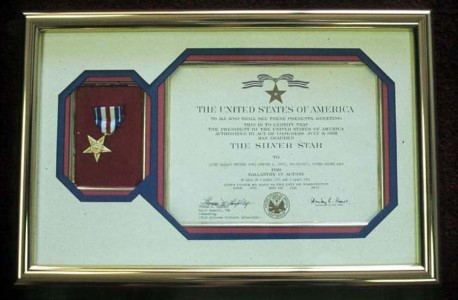 Photo 4: Silver Star
Photo 4: Silver Star
The military silver star and award framed in 1985, shows a contemporary presentation with deep bevels and hinged certificate. Note: The crooked medal is what happens when laying the frame on the floor to photograph and neglecting to check out the alignment of the star.
An Original Copy or Duplicate
An option for mounting and framing of originals is the possibility of purchasing duplicate originals at the time of issue. It is common for physicians to purchase additional copies of their board certification at the time they receive it. They realize that signatures are extremely important in verifying the authenticity of the certificate, and if certification cannot be proven, they could be passed over for future jobs.
To locally produce a duplicate copy is a copyright infringement and illegal with formal documents. One must remember that in addition to signatures changing in duplicates due to retirements and death, they may also be light fugitive. Some inks are visible light fugitive rather than by UV rays, and its the very light that makes the ink blue that will fade it away. It is not the signatures of many professional diplomas that are likely to fade but rather those of the less valuable ones. Most universities and certification boards use lightfast inks for signing or stamping signatures.
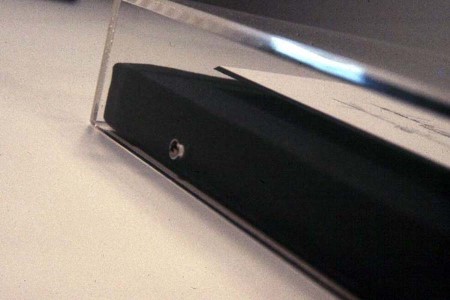 Photo 5: PPFA Attendance Certificate
Photo 5: PPFA Attendance Certificate
This PPFA Certificate of Attendance was framed by flush mounting in a dry mount press the paper to a mat board, trimming to the edges and floating it in a 2" deep acrylic box. This certificate is of significantly lesser value allowing for dry mounting than the above Silver Star.
The Final Mount
So in recap I want to reiterate the importance of understanding the limitations of, value of, and importance of, taking proper care of one-of-a-kind originals documents, diplomas and certificates. Being able to thoroughly discuss the options and suggestions is the most valuable element of your job as a frame design professional. Ethical limitations, physical tolerances and legal reasons why some of these precious documents may or may not be mounted is of utmost importance to know. Disclaimers are great, but will never keep you out of court or win your case.
Pay attention, do your homework, and you too may be a graduate of the mounting academy. Just consider for a moment how you framed your CPF certificate. How was it mounted and is the PPFA president who signed it for you still in office? Has the signature faded? What should you have done differently? Or did you do exactly everything the way you should have, just as you should always handle your customers precious diplomas, degrees and certificates.
END
Copyright © 2002 Chris A Paschke
For more articles on mounting basics look under the mounting section in Articles by Subject.
Additional information on all types of mounting is found in:
The Mounting and Laminating Handbook, Second Edition, 2002,
The Mounting And Laminating Handbook, Third Edition, 2008 and
Creative Mounting, Wrapping, And Laminating, 2000 will teach you everything you need to know about getting the most from your dry mount equipment and materials as an innovative frame designer.
All books are available from Designs Ink Publishing through this website.
Chris A Paschke, CPF GCF
Designs Ink
Designs Ink Publishing
785 Tucker Road, Suite G-183
Tehachapi, CA 93561
P 661-821-2188
chris@designsinkart.com
 Photo 1: Sheepskin Samples
Photo 1: Sheepskin Samples Photo 2: Flat Mounting
Photo 2: Flat Mounting Photo 3: Replaceable Certificates
Photo 3: Replaceable Certificates Photo 4: Silver Star
Photo 4: Silver Star Photo 5: PPFA Attendance Certificate
Photo 5: PPFA Attendance Certificate